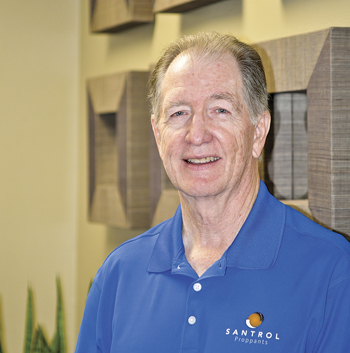Innovative thinkers
Richard Sinclair: Propelling the future of fracing
|
It is rare for a week to go by without a mention of hydraulic fracturing in the news. Despite being at the forefront of environmental and regulatory controversy, the practice has been in place for over 60 years–with almost 20,000 wells fraced in 2012 in the U.S., alone. Richard Sinclair, founder and president of Well Stimulation Inc., has been at the forefront of developing the technology that makes fracing safer and more economic, and is on a mission to educate the community about the reality of this unique process.
After graduating with BA and MA degrees in engineering from the University of Oklahoma, Sinclair began to look for an area of business he could sink his teeth into. “Research seemed more interesting, since the oil and gas area was still developing new ideas–especially interesting to me were production engineering and hydraulic fracturing,” he said. Sinclair joined Exxon Research and transitioned from mechanical to petroleum engineering, where he began to study fracing. While focusing on fracturing fluids and proppants, Sinclair had the unique experience of working for the U.S. National Aeronautics and Space Administration (NASA) on an Air Force assignment. Along with a team of engineers, Sinclair worked on heat shield designs for manned spacecraft flights. “My first success was the heat transfer effects on various frac fluids and proppants,” he said. Sinclair published several SPE papers and was awarded the Cedric Ferguson and Rossiter Medals for these published articles, at the age of 33. After 11 years with Exxon, during a time in which fracing became more acceptable to the industry, due in large part to the improvement of equipment and chemicals, Sinclair joined Maurer Engineering as a petroleum engineering consultant. He then met research partner John Graham. “There were many new developments for fluids, but almost none for proppants. In the 1960s and early 1970s, there was only sand, walnut hulls and glass beads,” Sinclair said. “John Graham and I both thought that better proppants could be made.” After many ideas and experimental trials, the two invented the commercial development of resin-coated proppant super sand, the industry’s first resin-coated proppant and the basis for the founding of Santrol in 1976. “It was now able to be a stronger proppant with no flowback and it was changeable to all kinds of field conditions,” Sinclair said. The temperature- and acid-resistant invention also allowed for a variety of resins to be used in oil and gas wells. While developing Santrol was a milestone in itself, Sinclair also worked to successfully market and sell the new product. “I started hiring the best sales people available, and then Santrol started offering much larger amounts of resin-coated sand to the oil and gas market,” Sinclair said. He continued his research into newer, better resin-coated proppants, and received 20 patents related to the technology. In 1992, Santrol was sold to Faimount Minerals. Sinclair became a long-term consultant for the company, which is now one of the largest fracing supply companies in the world, and founded his own venture, Well Stimulation Inc. He also created a series of Frac Fax newsletters, a Santrol history book and a book on well stimulation treatments for The University of Texas Petroleum Extension Service (PETEX). For over 20 years, Sinclair has taught about fracing, proppants and production engineering at Halliburton’s Energy Institute, as well as other oil and gas organizations. Sinclair believes that gas—and the technologies to extract it—have a very significant role in the future of energy development. “I am convinced that natural gas will continue to blossom for many years. The use of clean-burning natural gas can be used on cars, trucks, electric plants and many other types of industry,” he said. “Fracturing technology will help not only our United States, but also many countries around the world.” |
- Prices and governmental policies combine to stymie Canadian upstream growth (February 2024)
- U.S. producing gas wells increase despite low prices (February 2024)
- U.S. drilling: More of the same expected (February 2024)
- U.S. oil and natural gas production hits record highs (February 2024)
- U.S. upstream muddles along, with an eye toward 2024 (September 2023)
- Canada's upstream soldiers on despite governmental interference (September 2023)
- Applying ultra-deep LWD resistivity technology successfully in a SAGD operation (May 2019)
- Adoption of wireless intelligent completions advances (May 2019)
- Majors double down as takeaway crunch eases (April 2019)
- What’s new in well logging and formation evaluation (April 2019)
- Qualification of a 20,000-psi subsea BOP: A collaborative approach (February 2019)
- ConocoPhillips’ Greg Leveille sees rapid trajectory of technical advancement continuing (February 2019)



